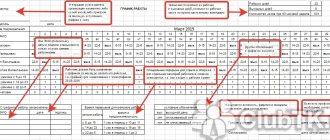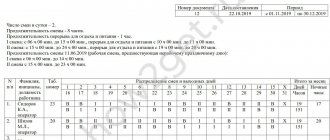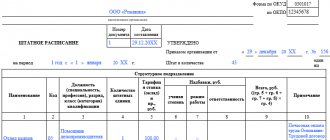Home / Labor Law / Payment and benefits / Wages
Back
Published: 04/07/2016
Reading time: 8 min
0
11383
Due to the nature of the work of some enterprises, they introduce a shift work schedule, in which employees work not one, but two or three shifts per day. This regime is appropriate, for example, for enterprises in which the duration of the production process is longer than the duration of work established by labor legislation. Also, several shifts can be introduced for more complete and efficient use of existing equipment.
In any of these cases, the question arises of how to properly organize the payment of employees and keep track of working hours. The rules and features of payment, as well as possible problems, are worth considering in more detail.
- Time tracking Daily
- Monday
- Summarized
- At a set hourly rate
The law allows you to work at night
Despite the fact that most organizations operate during the day, the specifics of certain types of work require night (and sometimes round-the-clock) operation. Just for such enterprises, there is a shift work schedule, according to which part of the shift or the entire shift falls during hours usually intended for sleep and rest.
The regulations for the organization and payment of such work are prescribed in Art. 96 and 154 of the Labor Code of the Russian Federation.
Is payment for night work included in wages in order to correlate it with the minimum wage?
What does shift work mean?
The rules for establishing a shift work schedule at an enterprise are prescribed in Article 103 of the Labor Code of the Russian Federation. This schedule implies the organization of work with:
- the duration of the production process is more than the normal duration of the working day;
- organizing more appropriate use of machinery, equipment, and production space;
- the need to increase production volumes;
- organizing round-the-clock operation of trade or public service facilities;
- other production factors.
Work can be organized in two, three or four shifts. At the same time, working for two shifts in a row is prohibited.
Which shifts are considered night shifts?
The law declares night work hours to be from 10 p.m. (10 p.m.) to 6 a.m.
A shift will be considered a night shift if at least half of it consists of work within the specified time period. Payment at the night rate will be only for the hours that make up this period; the rest will be rewarded, as is customary in day shifts. The definition of “night shift” in this case is significant for deciding the issue of attracting or not attracting a certain category of employees.
ATTENTION! According to Art. 96 of the Labor Code of the Russian Federation, the night shift should be 1 hour shorter than the corresponding day shift.
The night shift is not reduced by an hour in certain special cases, namely:
- the employee was specifically hired for night work, and this is reflected in the employment contract;
- the employee has a reduced schedule;
- The shift schedule is based on a 6:1 scheme;
- when the shift cannot be shortened due to the nature of production.
Question: How to pay for overtime work at night when recording working hours with a long accounting period (for example, a quarter)? View answer
How are “donor days” paid when working shifts?
In general, the donor is provided with two paid days of rest:
- day of blood donation;
- the day after donating blood.
The second day can be used immediately, or can be transferred to another working day or added to annual leave. During the rest period, the donor retains his average earnings.
But all this is true for a normal working day (8 hours). Rostrud spoke about “donor” vacation and its payment back in 2012 (Letter 402-6-1 dated March 20, 2012). The agency believes that the donor should be given 8 hours of rest. If the shift is longer (for example, 12 hours), then the employee will be required to work hours in excess of eight on another workday. And in Letter 14-2/OOG-1727, the Ministry of Labor clarified that the donor only needs to pay for 8 working hours, regardless of the actual duration of the shift.
Documents on payment for night work
An enterprise must necessarily regulate the conditions for organizing and calculating remuneration for work outside normal hours. This should be implemented in the following local acts:
- in the regulations on wages (general or issued specifically for night hours);
- in the collective agreement (the opinion of the trade union body must be taken into account)
- in an employment contract with an individual employee;
- in the order to attract an employee to work at specified hours (if this is done one-time or an employee is attracted from a special contingent).
IMPORTANT! An order is necessary only in special cases; with a permanent schedule with night shifts, it is enough to fix the payment procedure in the Regulations.
About exit compensation
Many employers agree to include compensation for evening hours in monthly bonuses. The same goes for night shifts.
But because of such actions, the content of Article 130 of the Labor Code becomes meaningless. Article 150 describes in detail incentive payments for going to work under conditions that differ from normal ones. Indeed, under such circumstances, certain efforts are required.
But evening hours are regulated separately by each company; no additional rules are provided in this direction.
Special contingent of personnel
Certain categories of employees do not have the right to work night shifts, without taking into account their opinion on this matter. Another list defines the circle of workers who can be involved in night work if they express their consent.
It is prohibited to work at night:
- women expecting a baby;
- minor workers, except for special categories provided for by the Labor Code of the Russian Federation and certain federal laws, for example, those involved in performances or other events.
You can work at night with written consent:
- mothers of young children (under 3 years old);
- disabled people of any group;
- employees who care for disabled people;
- workers caring for unhealthy family members (according to medical opinions);
- single parents with children under 5 years of age;
- guardians of children under 5 years of age.
FOR YOUR INFORMATION! An employee belonging to this category must be warned in writing that he has the right to refuse to work at night, and in turn, have his consent endorsed.
Time tracking during shift work
The law requires the employer to keep track of the time actually spent by employees. In this case, the form of ownership of the enterprise does not matter.
All data must be recorded in a special timesheet. Today there are 3 options for accounting under consideration:
- daily;
- Monday;
- summarized.
The first is used if:
- the length of the working week is from 5 to 6 days;
- shifts are the same length.
The second one is advisable to use when each week has an equal number of working days with the same number of hours. Actually, the duration of the shift in this case is regulated by the schedule adopted by management.
Factors determining the amount of pay for night shifts
The law establishes increased pay compared to daytime hours for each hour worked at night. The size of this increase depends on several important nuances:
- the minimum wage for night work established by the state;
- numbers set out in the relevant local act (usually the additional payment is a percentage of the daily salary or tariff);
- the number of night hours during which the employee was busy.
The amount of additional payment for each night hour of work cannot be less than a fifth of the regular daily salary (Article 154 of the Labor Code of the Russian Federation, Decree of the Government of the Russian Federation of July 22, 2008 No. 554).
NOTE! A shift schedule or a regular schedule is accepted in the organization; night hours are paid according to the same principle - with an additional payment.
Categories
The summary recording of working time is introduced by the employer in order to comply with the established normal working hours during the accounting period (month, quarter, etc.). The accounting period cannot exceed one year (Article 104 of the Labor Code of the Russian Federation).
When accounting for working time in aggregate, payment for working hours according to the schedule is made based on the established salary (tariff daily or hourly rate). For hours worked overtime, the employee is entitled to additional pay.
In organizations that use summarized working time tracking, average hourly earnings are used to calculate the average earnings of a specific employee. It is calculated by dividing the amount of wages actually accrued for the pay period by the number of hours actually worked during this period. The average earnings of a particular employee are determined by multiplying the average hourly earnings by the number of working hours in the period subject to payment.
The procedure for calculating average wages is established by Art. 139 Labor Code of the Russian Federation. The specifics of the procedure for calculating average wages are determined by the Government of the Russian Federation. Currently, they are approved by Decree of the Government of the Russian Federation of December 24, 2007 No. 922 “On the specifics of the procedure for calculating average wages” (hereinafter referred to as Resolution No. 922).
Resolution No. 922, in addition to the general rules for calculating average earnings, defines the specifics of calculating average earnings when recording working hours in aggregate.
Article 104 of the Labor Code of the Russian Federation determines in which cases an employee can be provided with a summarized recording of working time. If, due to the conditions of production (work) for an individual entrepreneur, in an organization as a whole, or when performing certain types of work, the daily or weekly working hours established for a given category of workers cannot be observed, then it is permissible to introduce summarized recording of working hours so that the working hours time during the accounting period (month, quarter and other periods) did not exceed the normal number of working hours. The accounting period should not exceed one year.
The normal number of working hours for the accounting period is determined based on the weekly working hours established for this category of workers (example 1).
Example 1
Ivanov works as a watchman, shift work - every other day, so the organization has established a summarized recording of working hours, the accounting period is a quarter.
In the second quarter of 2008, the normal number of working hours for a 40-hour work week is 493 hours.
Thus, the organization's employees must work no more than 493 hours in the second quarter of 2008. If employees work more than 493 hours, then the hours worked in excess of the specified amount of time will be considered overtime work (Article 99 of the Labor Code of the Russian Federation).
For employees working part-time (shift) and (or) part-time week, the normal number of working hours for the accounting period is reduced accordingly. The procedure for introducing summarized recording of working time is determined by the internal labor regulations.
According to paragraph 13 of Resolution No. 922, when determining the average earnings of an employee for whom a summarized recording of working time is established, except in cases of determining the average earnings for vacation pay and payment of compensation for unused vacations, the average hourly earnings are used.
Average hourly earnings are calculated by dividing the amount of wages actually accrued for hours worked in the billing period, including bonuses and remunerations taken into account in accordance with paragraph 15 of Resolution No. 922, by the number of hours actually worked during this period.
Paragraph 15 of Resolution No. 922 determines that bonuses and remunerations are taken into account in the following order:
- monthly bonuses and rewards actually accrued in the billing period, but not more than one payment for each indicator for each month of the billing period;
- bonuses and remunerations for a period of work exceeding one month, actually accrued in the billing period for each indicator, if the duration of the period for which they are accrued does not exceed the duration of the billing period, and in the amount of the monthly part for each month of the billing period, if the duration of the period for which they are accrued exceeds the duration of the billing period;
- remuneration based on the results of work for the year, a one-time remuneration for length of service (work experience), other remunerations based on the results of work for the year, accrued for the calendar year preceding the event - regardless of the time the remuneration was accrued.
If the time falling within the billing period was not fully worked by the employee or time was excluded from it in accordance with clause 5 of Resolution No. 922, then bonuses and remunerations are taken into account when determining average earnings in proportion to the time worked in the billing period, with the exception of bonuses accrued for actually worked time in the billing period (monthly, quarterly, etc.).
If an employee has worked an incomplete working period for which bonuses and remunerations are accrued, and they were accrued in proportion to the time worked, then they are taken into account when determining average earnings based on the amounts actually accrued in the manner established by clause 15 of Resolution No. 922.
The average earnings that are retained by the employee are determined by multiplying the average hourly earnings by the number of working hours according to the employee’s schedule in the period that is subject to payment (example 2).
Example 2
An employee of the organization, who was assigned a summarized recording of working time, was on a business trip for 14 days (from May 12 to May 25, 2008).
According to Art. 167 of the Labor Code of the Russian Federation, when an employee is sent on a business trip, he is guaranteed to retain his place of work (position) and average earnings, as well as reimbursement of expenses associated with the business trip.
Clause 9 of the Instruction of the Ministry of Finance of the USSR, the State Committee for Labor of the USSR and the All-Russian Central Council of Trade Unions dated April 7, 1988 No. 62 “On business trips within the USSR” (applied to the extent that does not contradict the Labor Code of the Russian Federation) it is determined that the average earnings during the time an employee is on a business trip are retained for all working days of the week according to the schedule established at the place of permanent work.
In this example, according to the employee’s work schedule, during his business trip there are four 24-hour shifts.
Let’s assume that for the billing period (from May 1, 2007 to April 31, 2008), an employee received a salary in the amount of 120,000 rubles; in the billing period, the employee worked 1,500 hours.
Let's determine the average hourly earnings:
120,000 rub. / 1,500 hours = 80 rub.
Let's calculate the average salary that an organization is obliged to pay to an employee while on a business trip:
80 rub. × 24 hours × 4 shifts = 7,680 rub.
Let us note that previously, for the calculation of vacation pay and the amount of compensation for unused vacation for employees who have a summarized accounting of working time, the Government of the Russian Federation established a special procedure (paragraph 4 of clause 13 of the Regulations on the specifics of the procedure for calculating average wages (approved by a resolution of the Government of the Russian Federation dated April 11 2003 No. 213 “On the peculiarities of the procedure for calculating average wages”).
According to the Regulations on the specifics of the procedure for calculating average wages, vacation pay was required to be calculated based on average hourly earnings. To determine it, it was necessary to divide the wages actually accrued for the billing period by the number of hours actually worked during this period (including overtime). The result obtained should have been multiplied by the established number of hours in the working week and by the number of calendar weeks of vacation.
Based on the calculations, it turned out that the average hourly earnings of an employee who worked overtime and received increased wages for this were the same as the average hourly earnings of an employee who did not work overtime and received a much lower salary. In other words, an employee who worked more hours than established by law was deprived of part of the average earnings saved for the period of annual paid leave. Therefore, the Supreme Court of the Russian Federation recognized paragraph 4 of clause 13 of the Regulations on the specifics of the procedure for calculating average wages as ineffective from the date of its adoption (decision of the Supreme Court of the Russian Federation of July 13, 2006 No. GKPI06-637).
Article 139 of the Labor Code of the Russian Federation defines the following: currently, payment of vacations and payment of compensation for unused vacations to employees for whom summarized recording of working time is established is carried out in the general manner. According to this article, the average daily earnings are calculated for the last 12 calendar months by dividing the amount of accrued wages by 12 and by 29.4 (the average monthly number of calendar days). Explanations on the procedure for paying vacations and paying compensation for unused vacations to employees for whom summarized working time recording is established are given in the letter of the Ministry of Health and Social Development of Russia dated August 27, 2007 No. 2608-17 (example 3).
Example 3
From June 16, 2008, an employee of an organization who has a summarized recording of working time is granted leave of 28 calendar days. The employee worked out the billing period in full (from June 1, 2007 to May 31, 2008). Let’s assume that for the billing period the employee received a salary in the amount of 204,000 rubles. In the billing period, the employee worked 1,800 hours.
Let's determine the average daily earnings of an employee:
204,000 rub. / 12 / 29.4 = 578.23 rub.
Let's calculate the amount of vacation pay:
RUB 578.23 × 28 days = 16,190.44 rubles.
According to Art. 139 of the Labor Code of the Russian Federation, the employer has the right to calculate the average salary using not only the 12 calendar months preceding the period during which the employee retains the average salary, but also other periods. This provision must be reflected in the collective agreement or local regulatory act. However, if the employer uses this right, then each time when calculating average earnings, the organization’s accountant will need to check whether the employee’s situation has worsened, that is, make two calculations: taking into account a different period established by the employer’s document, and in the generally established manner. The employee of the organization is paid the greater of the calculated amounts.
Night on a business trip
If an employee must work at night while on a business trip, this does not change the mandatory additional payment. The only difference is that the employer is not obliged to pay extra for night hours spent on the way to the business trip, although he can do this on his own initiative and desire.
How is a flight paid at night if an employee returns from a business trip on a day off and the flight is partially carried out at night?
What if it's overtime?
It’s one thing when night hours are included in the work schedule, and a slightly different situation when they end up being worked beyond the norm, even with a shift schedule. How to make payment in such cases?
It is necessary to apply both the extra pay per night and the overtime factor, which is 1.5 for the first two hours of overtime and 2 for the subsequent time.
Recycling
At enterprises where shift work is in effect, situations often arise when employees work more than required by law. To prevent this, you should be very careful when drawing up a shift schedule.
In doing so, they are guided by the following standards:
- over a year, processing cannot exceed 120 hours;
- for two days in a row - a maximum of only 4 excess hours is allowed.
At the same time, citizens included in certain categories are generally prohibited from engaging in overtime work unless absolutely necessary.
Please understand that the minimum surcharge is:
- first 2 hours 1.5 rates;
- in subsequent periods it increases to double size.
All such data must be displayed separately in the timesheet.
If you cannot do without overtime, then it is recommended to involve more employees in overtime and evenly distribute the time between them so that the total for each indicator corresponds to the legally established one.
Examples of night wage calculations
Example 1. Payment for night hours with a fixed salary
Employee Polivanov K.I. with a salary of 25 thousand rubles. per month Works on a shift schedule 5 days a week (Monday to Friday). His evening shift is from 20:00 to 04:00. According to his schedule, he has 10 such shifts per month. The local act of the enterprise establishes a 20% share of additional payment for work outside normal hours. We will calculate the amount of the surcharge.
For the accounting month Polivanov K.I. fully worked the hourly quota corresponding to the production calendar (170 hours). Night hours each shift account for 6 hours (from 22:00 to 04:00), for a month this will be 6 x 10 = 60 hours. We need to find the average hourly tariff rate: 25,000 / 170 = 147 rubles. Let's calculate the amount of the night supplement for each hour: 147 x 0.2 = 29.4 rubles. For 60 odd hours you will need to pay an additional salary of 60 x 29.4 = 1,764 rubles.
What is an advance and when should it be given?
Anyone who has worked for hire understands what an advance is on a practical level.
In the second half of the month, employees receive a certain amount. As a rule, it is some percentage of the salary. This part of the salary that employees receive during the pay month is traditionally called an advance. If we turn to labor legislation, the basis of which is the Labor Code of the Russian Federation, then this concept is explicitly absent there. But the Labor Code of the Russian Federation regulates the procedure for paying wages. Law dated July 3, 2016 No. 272-FZ introduced corresponding amendments to Art. 136 code. The current version of this article determines that employees must receive wages at least once every 2 weeks and no later than 15 calendar days from the end of the pay period.
It is clear that fully calculating your monthly salary is more difficult than calculating an advance. Therefore, in practice, the organization first determines the salary payment date. In accordance with Art. 136 of the Labor Code of the Russian Federation, it must be installed in the period from the 1st to the 15th of the next month. Which specific number to choose in this range depends on the organization of accounting at the enterprise. The better the exchange of information between services is organized and the higher the degree of automation of accounting, the sooner wages can be calculated and paid.
After setting the salary payment date, half a month (15 days) must be added to it. This is how the advance payment date is determined in accordance with the requirements of the Labor Code of the Russian Federation. For example, if the deadline for paying wages is set on the 4th, then the advance must be issued no later than the 19th, if it is 8th, then no later than the 23rd, etc.
What if you give an advance payment earlier than 15 days? For example, on the 12th when the salary payment date is 5. In this case, more than 20 days will pass from the advance payment to the next salary payment, which exceeds the period established by the Labor Code of the Russian Federation. In this case, the organization may be held liable for violating the payment procedure.
For more information, see “Paying wages ahead of schedule may result in a fine.”
Weekends and non-working holidays: calculation features
The minimum payment in such circumstances is double. But it depends on what schemes are used at the enterprise:
- In the case of piece workers, at least double piece rates are used.
- With daily and hourly tariff rates - regular rewards are also multiplied by two.
- Single or daily hourly rate is combined with salary.
You can use any internal regulations to establish the exact amount of compensation for a particular enterprise.
Employees receive increased compensation for hours during which they actually performed their duties. If part of a weekend and a holiday is transferred from a working day, then this part of the time is counted separately.
Remuneration of employees at any enterprise includes several components:
- Additional payments and allowances, bonuses, other incentive payments.
- Compensation transfers. This includes additional payment for work in difficult climatic conditions. Increased premiums are applied for work in areas prone to radioactive contamination.
- Additional payment for labor depending on the level of training of employees. The quality and conditions of the work performed also determine the result.
When calculating wages for holidays and weekends, in the evening, the employer must take into account the following factors:
- Tariff salary.
- Regional coefficients.
- Percentage allowances.
- Bonuses and compensation.
This law applies to all employers, regardless of their sector of employment.
Bonuses for working on weekends and holidays
Bonuses for work are calculated taking into account additional payments for shift schedules
Article 153 of the Labor Code states that wages are set only in accordance with a valid agreement between the interested parties.
It is necessary to take into account the system in force at a particular employer. When paying for work on a day off, almost all types of bonuses are taken into account.
If the contract specifies monthly bonuses, you cannot do without them.
Annual bonuses usually do not meet such criteria. Therefore, no accounting is carried out for this indicator.
The employer may provide other types of compensation:
- Financial assistance in connection with vacation.
- Compensation for the price of gasoline, car.
- Payment for food and travel.










